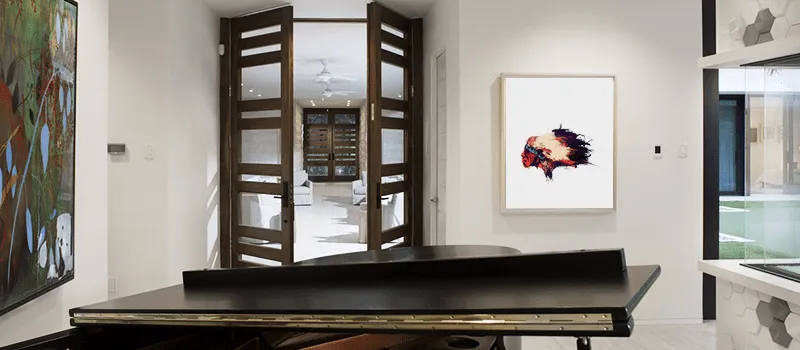Your front door is the first thing everyone sees when they approach your home or office. As a result, you have likely dedicated significant consideration to how your entry door appears from the exterior. However, you may not have considered how your main entrance front door design will impact the aesthetic of your entryway or the flow of the interior design in your home.
Your front door style and the design choices you select will make a difference inside your home or office, so your entry door should complement your space’s interior. Of course, there are cases where you want your entry door to stand out and make a bold statement intentionally, but most property owners aim to match the style of their modern front door to both the interior and exterior of their home or building.
Below, we share tips on what to consider when matching the main entrance front door design to the interior design style of your space.
Consider the Entry Door Style
The style of your front door is a critical first decision you will need to make if you are upgrading your entry door or selecting one for a new build. While there are abundant style options, entry doors typically come in traditional or modern styles.
Traditional entry doors are elegant and timeless, while modern entry doors are sleek and unique. Which you choose will depend on the architectural style of your home and your personal preferences.
When considering your door style decision, think about which interior design styles appeal to you too. For example, if your interior is light and airy, opt for a door that invites in natural light. On the other hand, if your entryway is traditional, consider a stately wood entry door that adds luxury to the space.
Choose a Suitable Entry Door Material
The material you choose for your entry door also positively or negatively impacts your aesthetic inside and out. For example, screened or metal front doors may not match a modern home and may detract from the elegance of a traditional home.
On the other hand, a wood exterior door may significantly enhance curb appeal and allow you to choose design details that elevate your interior at the same time. Wood doors also hold their value over time, making them a wise investment. You can choose from a variety of wood types.
Consider a craftsman-style entry door for your traditional home or select a modern style wood door to complement the clean lines and your new build.
Should All Interior Doors Match the Front Door?
Many homeowners wonder: Should the front door match the interior doors? The answer depends on your design goals. A matching scheme creates a sense of cohesion and flow, especially in open layouts where the front door and interior doors are visible together. It works particularly well in traditional or minimalist homes that have a uniform look.
On the other hand, contrasting styles can add character and visual interest. For example, a bold stained oak front door can be paired with lighter interior doors in neutral tones. As Architectural Digest points out, matching is not a strict rule. Cohesion can be achieved through complementary finishes, trims, or hardware, even when the doors themselves differ.
Design Trends for Matching Entry Doors and Interiors
Recent design trends show a growing interest in combining entry doors with interior aesthetics. Many modern homes use oversized pivot front doors that are finished on the inside to match hallway doors or cabinetry. Similarly, natural stains and matte finishes are being carried from the entryway through to the interior to create a warm and unified atmosphere.
Another trend is the use of dual-finish doors, a bold, weather-resistant exterior finish for curb appeal, paired with a softer, interior-friendly finish on the inside. This allows homeowners to balance practical performance with interior design harmony (Deuren).
Hardware and Finishes: Small Details That Tie Doors Together
Even if you choose different door styles, matching hardware and finishes can unify your spaces. Coordinated handles, hinges, and trims ensure consistency across the home and tie together a glass-panelled entry door with simpler solid-panel interior doors. For example, using brushed nickel hardware on both the interior front door and bedroom doors creates continuity. Similarly, matching stain tones or complementary paint colours can connect otherwise different door designs. According to Trimlite, small finish details often make the biggest impact in creating design harmony.
Select Complementary Stains and Paint Colours
The stain and paint colours on your front door will dramatically impact whether your entry door matches your home’s interior or detracts from the aesthetic. Darker stains demand attention in their own right and add richness, while lighter stains soften your entryway and create a brighter, welcoming area.
Conversely, bright paint colours may not work inside if your interior paint colours, flooring, and furnishing are more subdued or traditional. However, bright and bold options may be the perfect fit if your interior style is eclectic or your space suits a nice pop of colour.
If you find it challenging to decide, work with wood entry door experts who can guide you through the door design process from start to finish.
Match Your Interior with A Main Entrance Modern Door Design from Master Doors
At Master Doors, we are pleased to offer high-quality exterior wood doors that complement both the interior and exterior of any home or office space. Whether you choose a traditional entry door or opt for a sleek modern main entrance door design, our team of dedicated experts can assist you in making design choices that enhance your home inside and out. Contact the Master Doors Canada design team today at (647) 699-4657 to chat with our team and request a quote for a modern front door!
FAQ's
How do custom finishes help integrate entry doors and interiors?
Custom finishes allow homeowners to create doors that bridge interior and exterior design. A door can be built with a weather-resistant finish on the outside for durability, while the interior side can be stained or painted to match indoor décor. This ensures the entryway feels like a natural extension of the home.
Can interior doors differ from the front door but still look unified?
Yes. Interior doors don’t need to be identical to the front door to feel unified. By using complementary finishes, trims, or hardware, you can maintain design consistency while still allowing for variety. For example, a bold wood front door can pair well with painted interior doors if the handles or stain undertones tie them together.
Does matching doors increase property value or aesthetic flow?
Yes, matching or well-coordinated doors can improve both aesthetic flow and property value. Cohesive design makes spaces feel more intentional and polished, which appeals to potential buyers. While not always a direct financial return, a unified look enhances curb appeal and contributes to a home’s impression of quality.



